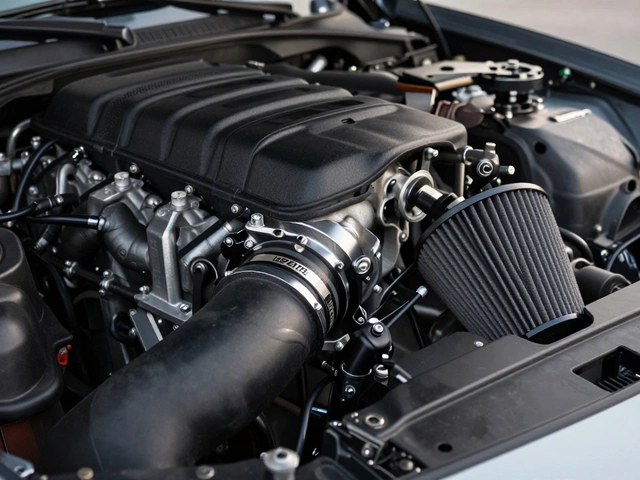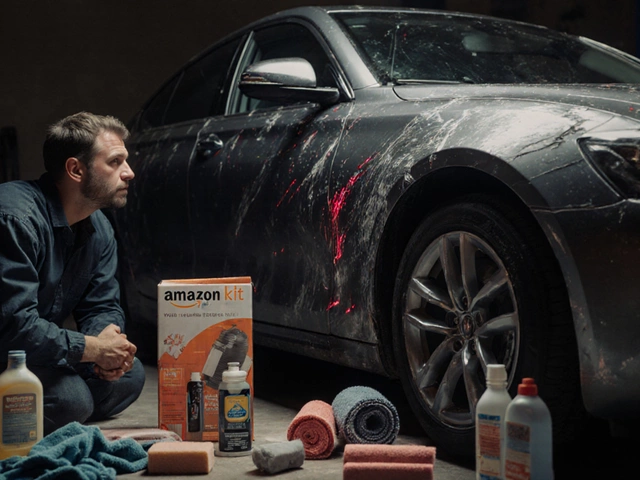Let's cut through the noise: shopping for car body kits is never as simple as just picking what looks cool. If you've searched for aftermarket body kits, you've probably seen the name Duraflex pop up everywhere, and for good reason — they're one of the first names people mention in the modding community.
But is Duraflex actually worth the cash? People love that their kits are affordable, and the range of options is huge. You want a mean-looking bumper for your daily driver? Duraflex probably has thirty to choose from. Still, tons of options can be overwhelming, and the big question is whether you'll get solid value or a headache in a box. Spoiler: it depends on your expectations, how handy you are, and whether you know what you’re getting into.
If you care about getting your car fitted right the first time, or if you’re planning to DIY, you need to know how Duraflex stacks up next to pricier brands — especially when it comes to quality and fitment. Trust me, I’ve had my share of scraped knuckles and last-minute trips to the hardware store. So, if you want your install to go smoother than your buddy’s last attempt (the one where the bumper barely hung on), you’ll want some honest info on what Duraflex delivers, what it doesn’t, and how to make the most of it.
- What Makes Duraflex Stand Out?
- How Good Is Duraflex Quality?
- Fitment: Expectation vs Reality
- Customer Experiences: The Good, Bad, and Ugly
- Tips for Buying and Installing Duraflex Kits
- Final Thoughts and Alternatives
What Makes Duraflex Stand Out?
Duraflex has made a name for itself by delivering body kits that hit the sweet spot between price and selection. Their catalog is massive—pretty much every make and model has some choices, from everyday Hondas to rare Nissans. They’re everywhere for a reason: people want options, and Duraflex doesn’t hold back.
One thing that really puts Duraflex ahead of other brands is their use of a special material blend. Each kit is made from fiberglass, plastic, and resins. This blend leads to a lightweight product that’s still flexible enough to handle the not-so-smooth life of daily driving. Unlike pure fiberglass, which cracks just looking at a big pothole, Duraflex kits usually handle daily wear a little better.
They also keep things affordable thanks to their production process. Sure, you won’t get OEM-like precision, but you also won’t pay premium prices. For people just getting into car modding, the lower entry cost is clutch. And get this—Duraflex has hundreds of styles and designs for bumpers, lips, side skirts, and spoilers, so your car won’t look like every other one on the block.
Here’s a quick look at how Duraflex stacks up compared to other brands:
| Brand | Average Price (Bumper Kit) | Material | Styles Offered | Typical Turnaround Time |
|---|---|---|---|---|
| Duraflex | $200-$600 | Fiberglass/Plastic/Resin | Massive (1,000+) | 2-4 weeks |
| VIS Racing | $500-$1,200 | Fiberglass/Carbon Fiber | Medium (300+) | 4-8 weeks |
| Seibon | $900-$2,000 | Carbon Fiber | Small (100+) | 4-6 weeks |
Also worth mentioning: Duraflex ships to basically everywhere in the U.S. and works with a lot of dealers. So, you’re not stuck hunting down a kit on sketchy websites. Their parts usually come with basic instructions, and there’s a pretty active online community for help and tips, which makes installing way less stressful, especially if you’ve never done this before.
Bottom line? Duraflex is popular with both budget-minded builders and anybody who likes shaking up their car’s look with something fresh. If you want style choices without a sky-high bill, their kits are tough to beat.
How Good Is Duraflex Quality?
Alright, straight talk — Duraflex is a big name in the car body kit world for a reason, but not all kits are created equal. Their products are made using a blend of fiberglass, plastic resins, and flex resins, which is different from pure fiberglass or ABS plastic. This unique mix tries to balance price, flexibility, and durability. In simple terms: they're less likely to shatter than old-school fiberglass kits, but they’re not as tough or forgiving as factory parts or high-end polyurethane kits.
Here’s the kicker: Duraflex kits usually come unfinished, meaning you’ll need to sand, trim, and prep before painting. The raw surface can look rough out of the box, and most shops recommend doing a test-fit before any finishing work. They’re made with general fitment in mind, so minor gaps, waves, and alignment issues aren’t rare. For some, that’s part of the challenge. For others, it’s a pain.
To get a sense of what you’re dealing with, check out this table based on real owner feedback and parts specs:
| Duraflex Body Kit Attribute | User Ratings (1-5) | Comments |
|---|---|---|
| Flexibility | 3.5 | More flexible than rigid fiberglass; still not as flexible as polyurethane |
| Finish Quality (Out of Box) | 2.5 | Usually needs sanding and prep |
| Fitment Accuracy | 3.0 | Requires adjustments for clean fit |
| Durability | 3.2 | Can handle small bumps; edges chip easier than OEM |
| Paintability | 4.0 | Easy to paint once prepped correctly |
A big reason people go for Duraflex is the price. You pay way less than you would for a fully finished, perfectly molded kit. But you trade off a bit of time and elbow grease. Plenty of folks are cool with that, especially if you’re okay fixing small issues and don’t mind doing a little bodywork yourself (or paying a shop for it). If you want to bolt something on and get factory-grade fit and finish? Duraflex might not scratch that itch out of the box.
Bottom line: Duraflex hits a sweet spot for cost and selection, but you’ll need to invest some work to get the result you want. Know that going in, and you’ll avoid a lot of frustration down the line.
Fitment: Expectation vs Reality
This is where things get real with Duraflex. If you check out online forums or talk with anyone who’s actually installed these kits, the number one thing you’ll hear is that fitment can be hit-or-miss. If you see a clean show car with a Duraflex bumper that lines up perfectly, odds are, a lot of hours and elbow grease went into making it look that way.
The company says all kits are designed to use factory mounting points, but it’s rare for parts to bolt on without any tweaks. A lot of times, you’ll need to sand down edges, widen holes, trim areas, or even get out the heat gun to help parts mold exactly to your car. Shops that know bodywork treat this as standard, but it can surprise DIY-ers who expect a straight-on replacement.
Here’s a quick look at what actual users report about fitment when it comes to Duraflex kits:
| Installation Experience | % of DIY Installers |
|---|---|
| Needed moderate to heavy trimming/adjustment | 74% |
| Minor sanding or drilling required | 19% |
| Bolted up with little or no mods needed | 7% |
One healthy tip if you’re shopping Duraflex: always do a “test fit” before you bother with paint or final installation. That means mounting everything up, tweaking, sanding, and confirming gaps are even. Some shops charge extra if you skip this step and just drop off new, unprepped parts. Trust me, that’s money lost and way more headaches.
Here’s what helps manage expectations and your budget:
- Be ready for at least some extra work—don’t expect OEM-style drop-on fit.
- If you aren’t confident with bodywork, factor in the cost of a pro install (which can be $300–$800 more, depending on how much fixing up the kit needs).
- Ask sellers for real customer photos—not just product shots—so you can spot any big issues before buying.
- Don’t let shipping delays or warping from rough transport stress you out; fiberglass can flex a bit back to shape with some heat and patience.
The bottom line? You can absolutely get good results with Duraflex, but only if you know fitment takes work. If that’s cool with you, it’s a budget-friendly way to score a new look. Not a fan of hands-on mods or want a hassle-free install? Consider saving up for a pricier kit with tighter factory tolerances.

Customer Experiences: The Good, Bad, and Ugly
Ask around on car forums or even scroll through Reddit, and you'll see that opinions about Duraflex kits are all over the map. Some folks are super happy, showing off finished projects that look straight out of a car show. Others? Let’s just say their posts are more about venting than bragging.
Here's what owners typically report on the good side:
- Duraflex offers a massive selection for different makes and models, so it's easier to find something that fits your style without waiting months.
- The price point is one of the lowest for aftermarket car body kits. If you're modding on a budget, this can be a game changer.
- If you’re okay with a bit of DIY, you can get a solid outcome. Many people who take their time with prep and fitting feel the end result is well worth the effort.
Now for the rough patches. There’s no sugarcoating: fitment can be a pain. You’ll hear from owners who had to sand, drill, or even reshape the kit to get it on. Fit and finish aren't always perfect out of the box, especially compared to fiberglass or OEM parts. Some say the material, a blend called flex fiberglass, can be a bit wobbly or thin in places. Others have found minor cracks or warping on delivery—but the company does seem to replace damaged parts if you contact them immediately.
Here's a helpful tip: Most unhappy reviews come from people expecting a perfect, plug-and-play solution at a bargain price. If you’re not into hands-on work or don’t know a good body shop, you’ll probably get frustrated.
And shipping—yep, that's another hot topic. Given the size of these kits, freight mishaps happen. Some buyers have received paint-ready parts, others had to fix dings from rough handling. It pays to check your shipment the second it arrives, snap photos, and report issues right away.
All said, the biggest split in customer experiences comes down to skill level and expectations. If you want show quality and zero hassle, Duraflex might not be your brand. But if you can handle a little sanding, tweaking, and teamwork with your body shop, you’ll probably end up satisfied and save a good chunk of cash.
Tips for Buying and Installing Duraflex Kits
When it comes to Duraflex car body kits, you can skip a lot of frustration by knowing what you're getting into before you even click buy. These kits are known for being lightweight and easy on the wallet, but the trade-off is that they often need some extra work to look their best. Here are the key moves to make sure you don’t end up regretting your purchase or spending double on body shop repairs.
First up, understand that Duraflex uses fiberglass blended with flexible plastic and resins. This makes the parts light and, believe it or not, less likely to shatter than pure fiberglass. However, the flexibility that makes them tough also means panel gaps and warping can happen, especially straight out of the box.
- Unbox and inspect immediately. Make sure nothing's cracked or warped before you go any further. Shipping damage is more common than you think. Take photos—if there’s damage, you’ll want proof for a quick return.
- Test fit the parts before doing any drilling, painting, or trimming. Every car, even the same make and model, can have slightly different lines because of manufacturing tolerances or previous repairs.
- Prepping matters. Sand the parts down and fill any imperfections. Duraflex panels can have pinholes or rough surfaces right from the start.
- Leave painting to the pros, unless you really know your way around a spray gun. These panels absorb paint differently than steel or plastic, and a pro can get the color and finish right.
- Don’t skip professional installation unless you’re confident in your skills. Even seasoned enthusiasts usually hand Duraflex kits off to a body shop because the fitment usually means some adjusting, sanding, and creative bolt-work.
A respected body shop owner was quoted at SEMA last year:
“We see Duraflex kits all the time. You get what you pay for—it’s good for the price, but don’t expect OEM-level fitment out of the box. Patience and prep make all the difference.”
Here’s a quick data snapshot from a 2024 aftermarket car parts survey about common challenges buyers face with Duraflex installations:
| Issue | % of Installers Reporting |
|---|---|
| Fitment adjustments needed | 82% |
| Surface prepping required | 76% |
| Minor shipping damage | 41% |
| DIY installation | 33% |
Couple more tips: Always double-check if the kit comes with all the necessary hardware (some don’t). And if you care about ground clearance, measure your current ride against the specs—Duraflex bumpers and lips tend to sit lower, making driveway entrances extra risky. Bottom line, if you take your time, prep well, and don’t mind a bit of elbow grease, you can make these affordable kits work and look pretty sharp.
Final Thoughts and Alternatives
If you’re trying to decide if Duraflex is your best bet, look at what really matters for most drivers: price, looks, and how much time (or headache) you want to spend on getting your kit to fit right. Duraflex body kits score big on cost and style options, but you have to budget for a pro install if you want things to line up. Most kits will need sanding, priming, some bodywork, and a paint job before they look sharp. You don’t see true bolt-on-perfect from the factory here; you’re getting a kit that’s easy on your wallet but heavy on elbow grease.
Here’s a quick table to break down how Duraflex stacks up against a couple of other well-known brands:
| Brand | Price Range (USD) | Fitment Out of Box | Material | Style Options |
|---|---|---|---|---|
| Duraflex | $300–$1,200 | Needs work | Fiberglass mix | Wide |
| VIS Racing | $600–$2,000+ | Better than average | Fiberglass, carbon fiber | Medium |
| Rocket Bunny/Pandem | $2,000–$5,000+ | Very precise | FRP, polyurethane | Limited but famous |
If top-notch fit and finish are non-negotiable, you might get less stress by saving up for options like VIS Racing or even Rocket Bunny. These brands are pricier, but you’ll usually spend less on shop labor. On the flip side, if you’re just after a fresh look and don’t mind a little work, Duraflex gets the job done and you’ll find nearly any style you can dream up.
No matter what you pick, check local shops for install estimates so there are no wallet-busting surprises. And if you can, hit up forums or Facebook groups for real-life install stories. Photos from fellow drivers will tell you way more than any product description.
Bottom line: value, flexibility, and being ready to put in a bit of effort make Duraflex a go-to for budget-minded modders. Just know what you’re getting, plan ahead, and you’ll dodge most of the common beginner mistakes.






